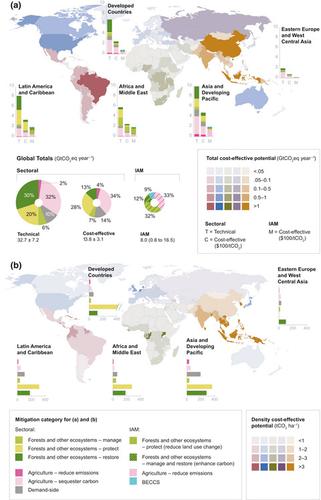当前位置:
X-MOL 学术
›
Glob. Change Biol.
›
论文详情
Our official English website, www.x-mol.net, welcomes your
feedback! (Note: you will need to create a separate account there.)
Land-based measures to mitigate climate change: Potential and feasibility by country
Global Change Biology ( IF 10.8 ) Pub Date : 2021-10-11 , DOI: 10.1111/gcb.15873 Stephanie Roe 1, 2 , Charlotte Streck 2, 3 , Robert Beach 4 , Jonah Busch 5 , Melissa Chapman 6 , Vassilis Daioglou 7, 8 , Andre Deppermann 9 , Jonathan Doelman 8 , Jeremy Emmet-Booth 10 , Jens Engelmann 11 , Oliver Fricko 9 , Chad Frischmann 12 , Jason Funk 13 , Giacomo Grassi 14 , Bronson Griscom 5 , Petr Havlik 9 , Steef Hanssen 15 , Florian Humpenöder 16 , David Landholm 2, 16 , Guy Lomax 17 , Johannes Lehmann 18 , Leah Mesnildrey 2, 19 , Gert-Jan Nabuurs 20, 21 , Alexander Popp 16 , Charlotte Rivard 22 , Jonathan Sanderman 22 , Brent Sohngen 23 , Pete Smith 24 , Elke Stehfest 8 , Dominic Woolf 18 , Deborah Lawrence 1
Global Change Biology ( IF 10.8 ) Pub Date : 2021-10-11 , DOI: 10.1111/gcb.15873 Stephanie Roe 1, 2 , Charlotte Streck 2, 3 , Robert Beach 4 , Jonah Busch 5 , Melissa Chapman 6 , Vassilis Daioglou 7, 8 , Andre Deppermann 9 , Jonathan Doelman 8 , Jeremy Emmet-Booth 10 , Jens Engelmann 11 , Oliver Fricko 9 , Chad Frischmann 12 , Jason Funk 13 , Giacomo Grassi 14 , Bronson Griscom 5 , Petr Havlik 9 , Steef Hanssen 15 , Florian Humpenöder 16 , David Landholm 2, 16 , Guy Lomax 17 , Johannes Lehmann 18 , Leah Mesnildrey 2, 19 , Gert-Jan Nabuurs 20, 21 , Alexander Popp 16 , Charlotte Rivard 22 , Jonathan Sanderman 22 , Brent Sohngen 23 , Pete Smith 24 , Elke Stehfest 8 , Dominic Woolf 18 , Deborah Lawrence 1
Affiliation

|
Land-based climate mitigation measures have gained significant attention and importance in public and private sector climate policies. Building on previous studies, we refine and update the mitigation potentials for 20 land-based measures in >200 countries and five regions, comparing “bottom-up” sectoral estimates with integrated assessment models (IAMs). We also assess implementation feasibility at the country level. Cost-effective (available up to $100/tCO2eq) land-based mitigation is 8–13.8 GtCO2eq yr−1 between 2020 and 2050, with the bottom end of this range representing the IAM median and the upper end representing the sectoral estimate. The cost-effective sectoral estimate is about 40% of available technical potential and is in line with achieving a 1.5°C pathway in 2050. Compared to technical potentials, cost-effective estimates represent a more realistic and actionable target for policy. The cost-effective potential is approximately 50% from forests and other ecosystems, 35% from agriculture, and 15% from demand-side measures. The potential varies sixfold across the five regions assessed (0.75–4.8 GtCO2eq yr−1) and the top 15 countries account for about 60% of the global potential. Protection of forests and other ecosystems and demand-side measures present particularly high mitigation efficiency, high provision of co-benefits, and relatively lower costs. The feasibility assessment suggests that governance, economic investment, and socio-cultural conditions influence the likelihood that land-based mitigation potentials are realized. A substantial portion of potential (80%) is in developing countries and LDCs, where feasibility barriers are of greatest concern. Assisting countries to overcome barriers may result in significant quantities of near-term, low-cost mitigation while locally achieving important climate adaptation and development benefits. Opportunities among countries vary widely depending on types of land-based measures available, their potential co-benefits and risks, and their feasibility. Enhanced investments and country-specific plans that accommodate this complexity are urgently needed to realize the large global potential from improved land stewardship.
更新日期:2021-11-03









































 京公网安备 11010802027423号
京公网安备 11010802027423号